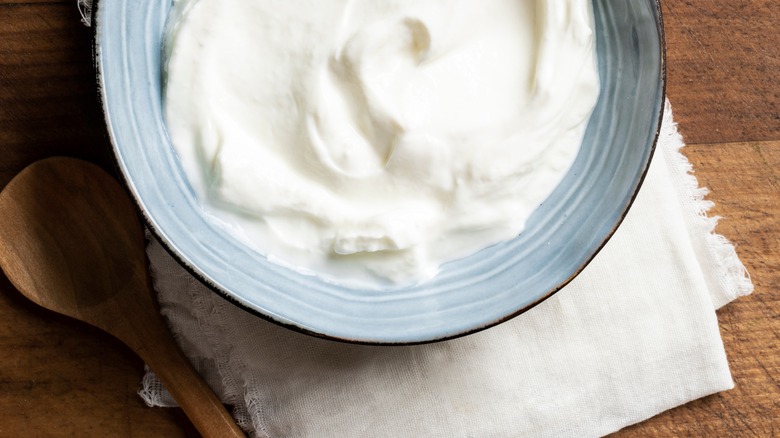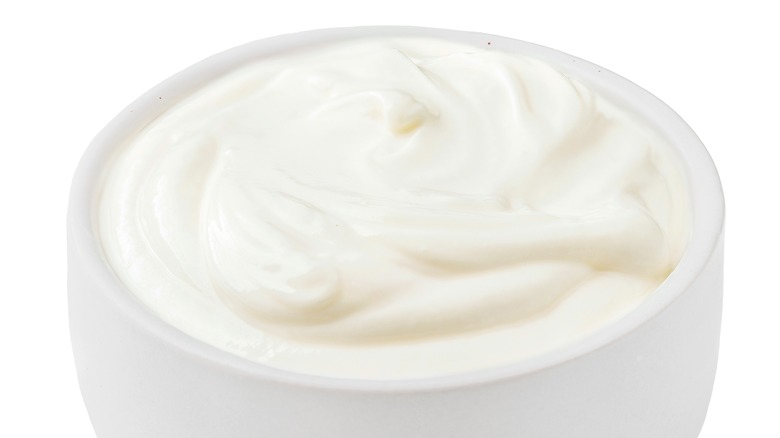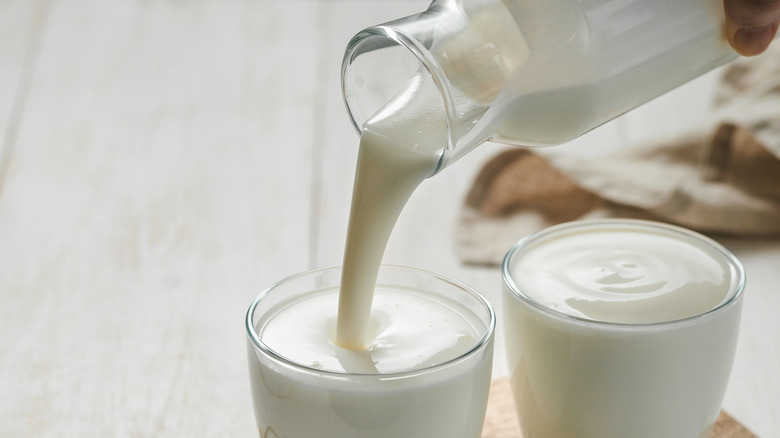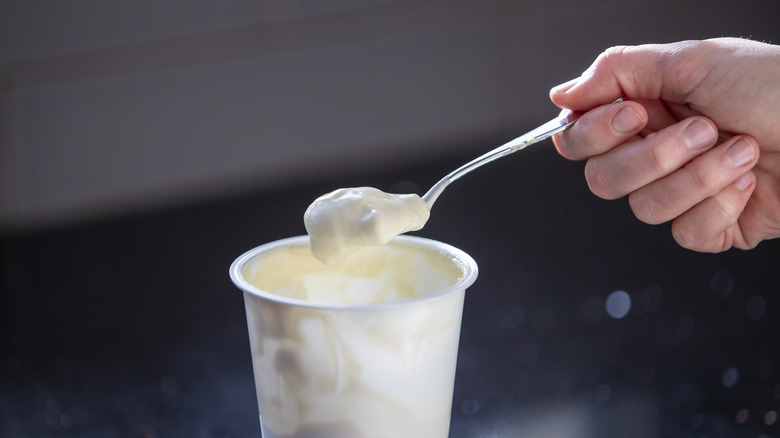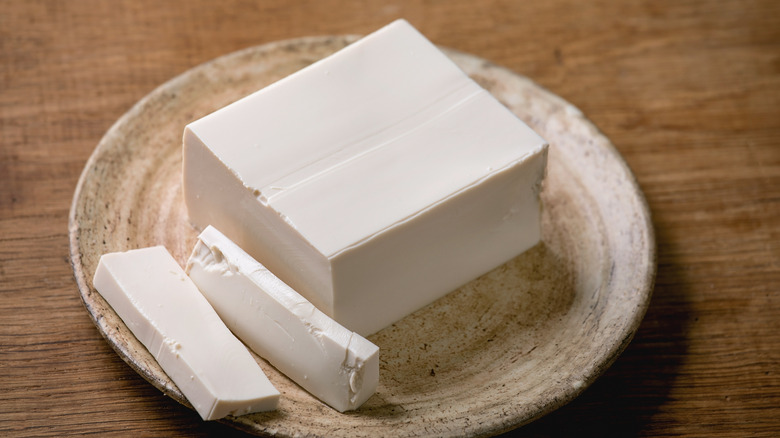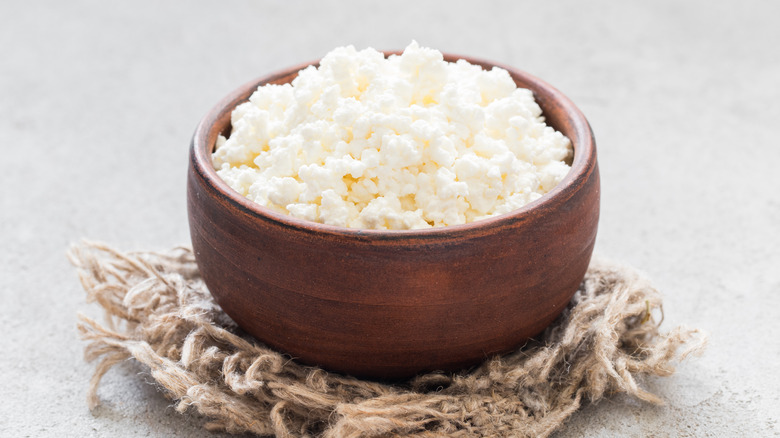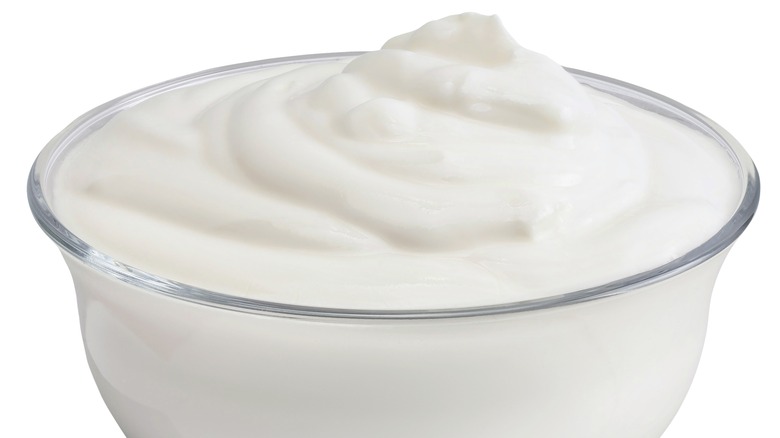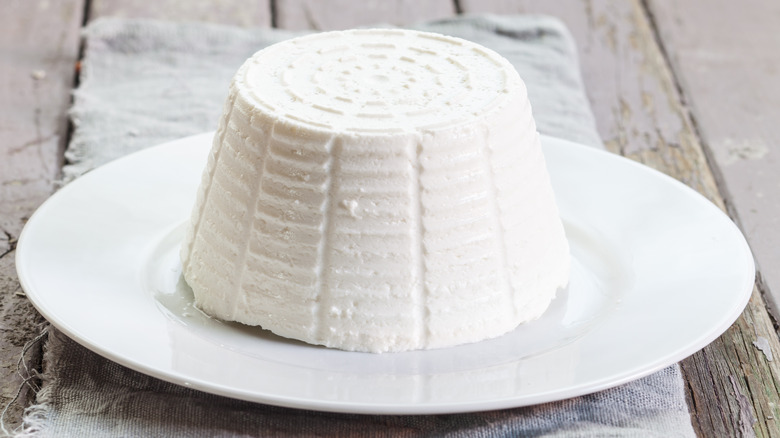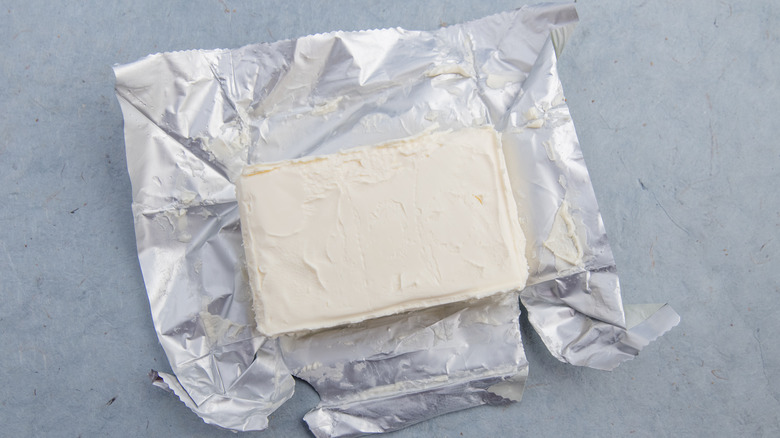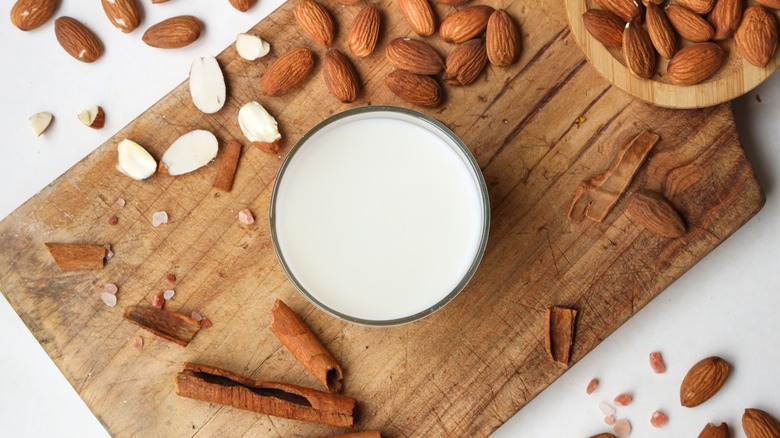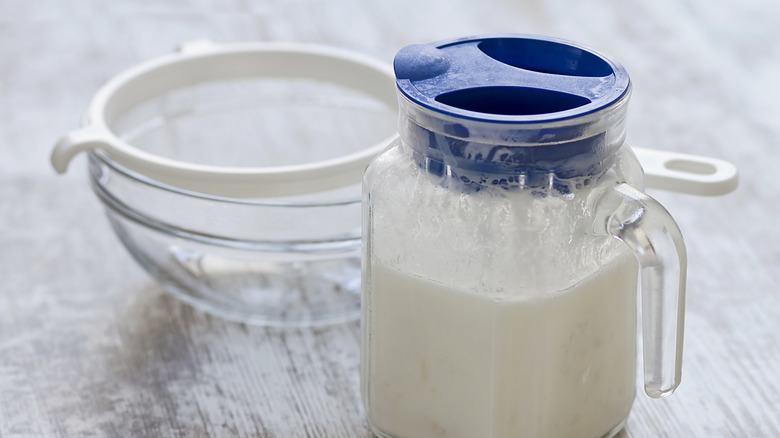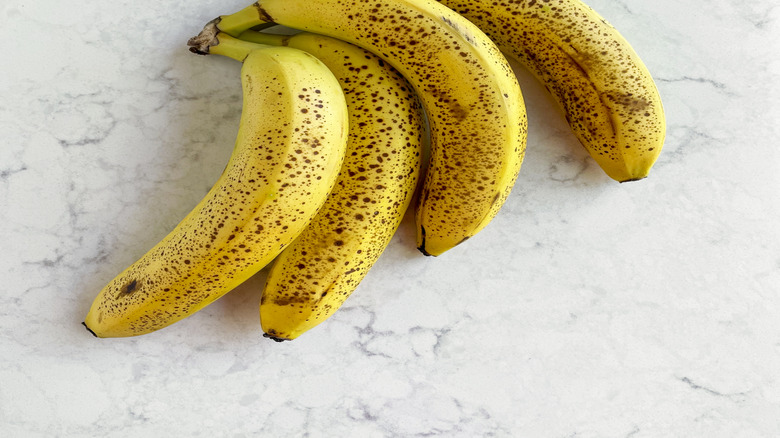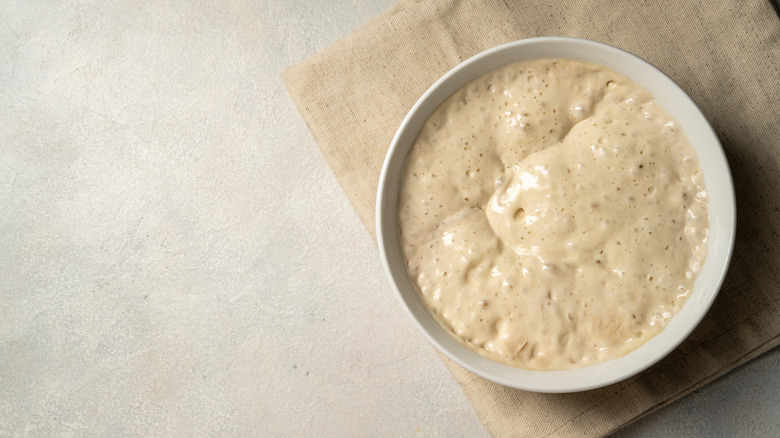12 Baking Ingredients That Can Be Substituted For Greek Yogurt
We may receive a commission on purchases made from links.
Greek yogurt is a wonderful ingredient. The yogurt is high in protein, you can make Greek yogurt yourself from milk, and it easily becomes a delicious pudding snack. There are too many reasons to count when it comes to the benefits of using Greek yogurt in your everyday life and baked goods ... but what if you don't have any? Then it's time to substitute. Chowhound spoke exclusively with several experts about the best substitutes for Greek yogurt when baking.
You can't just sub other types of dairy or non-dairy in willy-hilly, though. "Greek yogurt adds moisture, tanginess, and structure to baked goods," explains Marissa Stevens, the recipe developer behind Pinch and Swirl. "The thickness helps avoid soggy middles while the acidity activates baking soda for a proper rise. When I'm testing recipes, I notice that the protein in Greek yogurt gives a tender crumb without heaviness. Any substitute should match both the consistency and that slight tang."
There are a few other caveats. You can't use substitutes in just anything, warns Tatiana Kamakura, baker and founder of Milk and Pop. Instead, look for forgiving recipes that can handle the change. "Greek yogurt and its substitutes work well in cakes, muffins, pancakes, quick breads, and scones," she says. "It can also be used in savory baked goods like flatbreads." Also, plain Greek yogurt is typically unsweetened, so you should either use unsweetened substitutes or account for the added sugars by reducing other sweeteners. Keep in mind, too, that yogurt doesn't stay fresh forever. Always check the expiration date. And remember that substitutes may not offer the same chemical properties needed in baking. Now, onward!
Sour cream
A substitute is unlikely to replicate perfectly the role of any ingredient in a recipe. That's why it's a substitute. However, with some, you can get pretty close. For instance, a cultured product such as Daisy sour cream has many of the same properties as Greek yogurt: high acid levels, tang, and creaminess. Because of this, Tatiana Kamakura says, you can swap it in for Greek yogurt in a 1:1 ratio. As a bonus, Marissa Stevens says, many people always have it on hand — she certainly does.
Plus, notes Jennifer Pallian — creator of Foodess, a registered dietician, and Saveur Blog Awards "Best Original Recipes" Finalist — it's higher in fat than Greek yogurt, which can lead to an even richer mouthfeel in your final product. If you are looking to add Greek yogurt or its substitute to a recipe that doesn't already call for it, just be sure to make adjustments so you won't disrupt the moist-to-dry ingredient ratio, she says.
Buttermilk
Next up on the substitute ingredient list is buttermilk, which has great acidity and tenderness, Jennifer Pallian says. However, it has some downsides, the main one being it's much thinner. "Greek yogurt is thick, so thinner substitutes might throw off your batter consistency. A muffin made with Greek yogurt will be taller than the same recipe made with buttermilk," she says, adding, "The end product won't have quite as much loft." That's because buttermilk undergoes a significantly different production process than Greek yogurt. "Watch the moisture content," she concludes.
How do you do that? First, says Lisa Richards, the nutritionist behind The Candida Diet, you should use ¾ cup of buttermilk for every cup of Greek yogurt. Also, Marissa Stevens adds, "You may need to whisk in a tablespoon or a bit more of flour to thicken it up."
Note that low-fat buttermilk and buttermilk are often interchangeable in recipes due to a negligible difference in percentage of fats, so you're usually okay going with an option such as Organic Valley low fat cultured buttermilk if you can't find a full-fat version online or at your local grocery store. On a final note, you can substitute Greek yogurt when you're out of buttermilk as well, says Marissa Stevens: "I use [Greek yogurt] in scones, biscuits, and skillet cornbread in place of buttermilk, adding 1/4 cup water to 3/4 cup Greek yogurt" to achieve a buttermilk-like consistency.
Regular yogurt
Greek yogurt makes a great fat substitute in recipes, but what if you only have regular yogurt? Can you just throw that in one-to-one? Well, kind of, says Jennifer Pallian. Greek yogurt is strained to remove a lot of its whey while regular yogurt is "looser and has more whey," she says, adding that Greek yogurt's "reduced water content means you're not dumping excess moisture into your batter, so your muffins or cakes stay moist, not wet or gummy."
If you are going to use plain yogurt as your baking ingredient, strain it for a bit or reduce other liquids in your recipe. But, Pallian says, you can sub one-to-one "if you're not worried about the slightly thinner batter." If you're going to take the straining route, Marissa Stevens says, just put it through a coffee filter for about 30 minutes to get out some of that whey (and then reserve the whey for other baking or cooking purposes). And, she says, pay attention to thickness differences in store brands: she recommends Nancy's plain whole milk yogurt for a thicker alternative.
Either way, when choosing yogurts, make sure to buy high-quality brands at the grocery store. Know that some are tangy while some are quite sweet and may compromise the flavor for which you're shooting. Siggi's Icelandic strained nonfat yogurt, which is closer to skyr, a popular Icelandic food, is thicker than regular yogurt even though it's nonfat.
Silken tofu
For a non-dairy Greek yogurt baking substitute, you might try an ingredient such as silken tofu. This is easy to find in grocery stores, Asian markets, and online. Brands like 365 by Whole Foods Market organic silken tofu or Mori-Nu extra-firm silken tofu are both affordable and reliable. Silken tofu adds protein, moisture, and a neutral taste when you use it in a 1:1 ratio for baked goods, Lisa Richards says.
However, she adds, it lacks acid, which makes it an incomplete substitute. Remember, Richards says, "Greek yogurt adds moisture, tenderness, slight tanginess, and protein while helping baked goods stay soft. It also contributes to structure due to its acidity, which reacts with leavening agents." When you choose a substitute, says Ken Tobby, bromatologist and founder of Organic Solace, you must use "alternatives that provide a comparable balance of fat, acidity, and thickness ... to retain the desired rise and texture." Or, alternatively, you must combine a few substitutes to achieve the same result.
The easiest way to do this when using tofu as a substitute is to also add a splash of lemon juice, says Marissa Stevens. That will activate the baking soda and lead to the rise you want. Or, Jennifer Pallian adds, you could just avoid this swap in any recipe that calls for baking soda. As always, experimentation is key.
Cottage cheese
"Blended cottage cheese sounds strange but works surprisingly well," Marissa Stevens says. You can use this baking substitute in a 1:1 ratio, which makes it an easy ingredient to swap in for Greek yogurt, but you have to take care of the texture first. "Just blend until smooth first and strain with a coffee filter if it seems particularly watery," Stevens says. Note, though, it's not the best choice for a recipe that also calls for baking soda, Jennifer Pallian says, because it has significantly lower acidity. You may wish to add some lemon juice or vinegar to activate your leavening agent.
If you're going to use cottage cheese, a product such as 365 by Whole Foods Market organic cottage cheese will probably do the trick. You can also get cottage cheese brands that are made with real milk but are safe for the dairy-sensitive, such as Good Culture organic lactose-free cottage cheese. Note that this doesn't mean it's dairy-free, however; it simply means it has added lactase, which is an enzyme needed to digest dairy that many people are missing. For that reason, you should be careful to whom you serve baked goods made with lactose-free products. Always ask about dietary restrictions, and you won't run into problems.
Crème fraîche
As far as substitute baking ingredients go, crème fraîche is pretty delicious. As the name suggests, it's French, and it's employed in everything from baked goods to desserts to omelets. Although it is similar to sour cream in thickness and tang, crème fraîche is thicker and richer because it is made with a combination of heavy cream and buttermilk. Its fermentation process gives it many of the same attributes and benefits as Greek yogurt, and it's lovely in cakes and quick breads, Jennifer Pallian says.
"Crème fraiche is a good substitute with a similar texture, thickness, and acidity," Tatiana Kamakura says. "Use it in a 1:1 ratio." Lisa Richards notes that, despite the acidity, it does have a bit less tang than Greek yogurt, so if you're worried about flavor, you might add a bit of something sharp and bright, such as lemon juice. Still, a product such as Vermont Creamery crème fraîche should give you most of what you're looking for on its own. The opposite is true as well, by the way. If you're fresh out of crème fraîche (as this writer always is), try Greek yogurt instead.
Ricotta
If you're like many people in the United States, you likely associate ricotta with lasagna and only lasagna. Okay, maybe the occasional Italian cheesecake as well. But still, it's probably never occurred to you as a substitute baking ingredient, right? Well, that's a shame because it's a good one. Your average grocery store brand ricotta — Galbani whole milk ricotta cheese, for example — can take care of your Greek yogurt problem.
Ricotta is creamy but milder in flavor, Lisa Richards says. It's good for denser baked goods that don't need a lot of acid reaction, such as flatbreads or cookies. Yes, cookies! Greek yogurt creates a fantastic chew factor when added to cookies, Marissa Stevens points out. But if you plan on substituting Greek yogurt with ricotta in your cookies, make sure to use only in recipes that don't call for baking soda, or be sure to add an acid to compensate for the lack of it.
As for actually adding it, you can use ricotta in a 1:1 ratio in place of Greek yogurt. Don't forget to blend it first, otherwise you'll get a grainy texture that may affect the final result. Remember, Stevens says, sometimes your substitutes will change the flavor of your baked good, but that's okay. "Some of my best recipe tweaks have come from necessary substitutions," she says. And finally, Ken Tobby says, "Temperature matters a lot. Using a cold alternative straight from your fridge can compromise how different ingredients react and mix. Thus, letting your substitute warm to room temperature before using it can enhance consistency in your batter."
Cream cheese
It's probably no surprise that cream cheese works pretty well as a substitute for Greek yogurt in baking. They're both made of cow dairy, and both are creamy, smooth, and flavorful, although cream cheese does have less tang than Greek yogurt. It's also denser, even at room temperature. For this reason, Marissa Stevens says, you should mix ¾ cup of cream cheese with 2 tablespoons of milk in place of one cup of Greek yogurt.
Once again, cream cheese works better in denser baked goods because it lacks acid. Therefore, Ken Tobby says, "It might fail to react appropriately with baking soda, resulting in less rise." At risk of sounding like a broken record, add some extra acid such as a splash of vinegar or lemon juice. "In addition," he explains, "if you are substituting Greek yogurt in a product that depends on its protein or fat content for structure — for instance, high-protein breads or muffins -– you might have to use an extra binding substance such as eggs to achieve the desired texture."
You can experiment with products such as 365 by Whole Foods Market whipped cream cheese or a regular cream cheese spread to see which gives you the better results. Per usual, this will depend on the recipe.
Coconut or almond milk yogurt
You can also use a non-dairy ingredient such as Kite Hill plain unsweetened almond milk yogurt or Siggi's 2% Icelandic strained low-fat coconut yogurt as your baking substitute. These types of yogurts vary widely in their texture, ingredients, and acidity, though. You may need to experiment with them, Marissa Stevens says.
There are a few other cautionary items to note. For one thing, the flavors of these yogurts can be quite strong, either from the nuts or from other ingredients. You should always consider their effect on the taste of your recipe, Lisa Richards says. And Stevens reminds home cooks to plan ahead. "Room temperature yogurt blends much better than cold," she says. Greek yogurt also adds fat, which tenderizes the baked good and helps to emulsify the other ingredients. Since dairy is a natural emulsifier, using plant-based alternatives may require you to add an additional ingredient, such as eggs, to help bind everything together.
Kefir
"Kefir has a similar tang to Greek yogurt," Tatiana Kamakura explains. "Since it's thinner, like buttermilk, I would use about ¾ cup of kefir for every cup of Greek yogurt." This is important, she says. "What I see most often is people not adjusting the liquid content properly when using thinner substitutes. Too much moisture can lead to various problems, from dense, flat baked goods to longer baking times." Ken Tobby warns that, either way, you may be in for a different result. "Overcompensating with additional flour to counter a thinner alternative can lead to a heavy, tough texture," he says. Note that you can make kefir thicker by pouring it through a strainer lined with cheesecloth. Either way, Lisa Richards says, don't expect the exact same results in the texture, rise, and crumb of your baked goods when making substitutions; just enjoy what you get.
Also, note that many kefirs you will find at the store or online are low-fat, such as Lifeway organic low-fat kefir. The low-fat varieties are sometimes thinner, though, so they may not give the same results as Greek yogurt, even if you adjust the amount. If you find that's the case, try a higher-fat version, such as Nancy's Yogurt organic plain whole milk kefir.
Mashed bananas
As always, mashed bananas have a rightful spot on the list. A common enough ingredient in baking on their own (hello, banana muffins and banana bread), they are also a great substitute for anything from eggs to oil because they're moist and tenderizing due to their pectin content. They are also mildly acidic but probably not enough to make a complete Greek yogurt substitute. This could affect the flavor and texture, Tatiana Kamakura says, as acidic ingredients act as tenderizers and also activate leavening agents. "If using baking soda as a leavening agent, make sure there's another acidic ingredient to activate it," she explains. Again, a dash of lemon juice or vinegar can work well here.
That said, bananas are a nice substitute. "In sweet baked goods like muffins or quick breads, mashed bananas provide moisture and subtle sweetness," Kamakura says. "Use about ½ cup of mashed banana for each cup of Greek yogurt." She cautions against using them in savory applications, though, because there's just no hiding the sweet factor. Not only that, Ken Tobby says, but bananas always taste like ... well, themselves, and that's a very unique flavor. You'd better plan for that in the final result. And if you don't want that distinctive taste, use something else.
On a final note, you've got to watch out for the macronutrient content. "People also miss that Greek yogurt adds protein for structure," Marissa Stevens says. If you use bananas instead, you might want to add another ingredient that will strengthen the final result. Eggs, for instance, add to the structural integrity of baked goods, helping to trap air and keeping them from collapsing.
Sourdough discard
Sourdough starter is different from all of the other options on this list in one important way: You can't simply buy it at the store — although you can buy cultures such as Breadtopia live sourdough starter or Cultures for Health San Francisco sourdough style starter culture that will make the job easier. Even if you do that, though, making starter is a labor of love, though one that will provide rewards many times over once you begin to use it in your baked goods. And because you must feed your starter on a regular basis and discard the extra, you can begin to use that extra in baking. This is called "sourdough discard," and it's a great substitute for Greek yogurt.
"Sourdough discard offers acidity, thickness, and moisture similar to Greek yogurt," Tatiana Kamakura says. "The natural acids in the discard can help activate baking soda, making the baked goods rise and contributing to a soft, tender texture." Typically, you can use sourdough discard in a 1:1 ratio for Greek yogurt, but she cautions that you may need to adjust other liquids to balance its consistency. "Sourdough discard can be thicker or thinner depending on how it's stored," she explains. When first using discard, you may want to stick with a tried-and-true recipe so you know what it's supposed to look like consistency-wise.
And remember, Jennifer Pallian says, "substitutions work best in forgiving recipes — think easy muffins, not a technique-heavy cake." Just the same, Lisa Richards adds, feel free to experiment. You never know what unique textures and flavors you'll come up with when you do.
